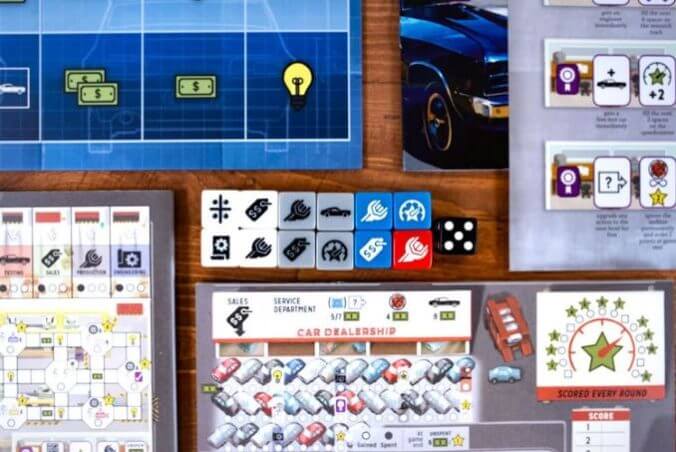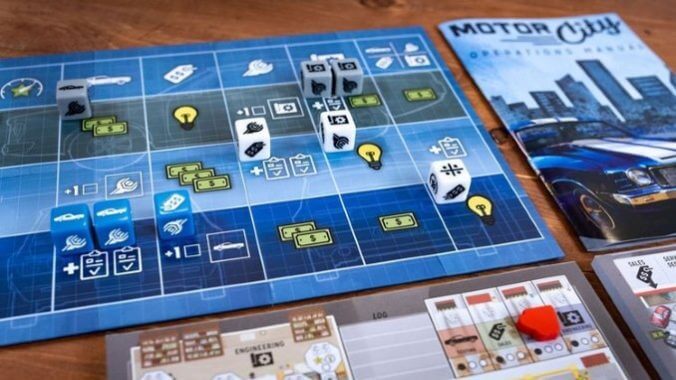Motor City is the latest roll-and-write game from Ben Pinchback and Matt Riddle, co-designers of last year’s outstanding roll-and-write Three Sisters and the earlier Fleet: the Dice Game, along with Godspeed designer Adam Hill. The feel is similar to those other roll-and-write games, with players working on two scoresheets; choosing from a large, shared dice pool; and trying to find the best way to maximize their bonuses across both sheets to mark off as many spaces as possible.
In Motor City, you’re trying to build an automotive factory in the heyday of American carbuilding, with score sheets that include four main areas—Production, Testing, Sales, and Engineering—plus a Speedometer and a smaller area, Research, that serves as a catch-all space like the Compost area in Three Sisters. All four of those areas have tracks you’ll fill out one to three boxes at a time, with each of the four working a little bit differently, although all four share the common trait that many boxes you check off give you bonuses like filling out boxes somewhere else on the board. When the game begins, you choose one of the three tracks for Testing, and one of the six tracks in Engineering.
On every turn, the active player rolls all of the dice for your player count, then arranges the dice by color (grey, white, or blue) and face value on the central board. Players then go around selecting dice, gaining the bonus shown in the space where the die was, then taking an action in the area shown on the die’s face, and then placing the die on their score sheet in one of the four areas to take that action. This is where it gets a little complicated: When you take the action for one of the four areas, you get to mark off one space, OR you can ‘upgrade’ that action for future turns to allow you to mark off two or three spaces. You can do that when you take the action from picking up the die, but not the second action where you place it on your score sheet. In every round, each player will draft two dice, leaving one die on the board, which all players use just for the face action. So you do three things for every die you pick up: get the bonus, take the face action/upgrade, then place it on your sheet and take that action. You get two dice per round, then the one action for the die remaining, which is seven things you get to do in every round.

The Speedometer gives you points in every one of the game’s eight rounds once you’ve marked the second space, worth one point, and you can continue moving up the dial to increase those points, either by taking a die with a Speedometer face or getting to any of the Speedometer bonuses around the board. There are also four Certifications available, with a maximum of three achievable per game, that give you an instant benefit or game-end points, while you must get at least one Certification to max out some of the Production bonuses. The Research area gives you a bonus for every three spaces you mark off, which can be a free action of any type or a one-time gain like opening another Engineering track.
It’s one of the more intense roll-and-write games I’ve tried, not as complex as Twilight Inscription, but enough that I have had a hard time tracking everything I had going by the later rounds. As in Three Sisters, there’s tremendous satisfaction in setting up a big play, where one die lets you mark off a whole slew of spaces across your score sheets, and by the last two rounds you can generally see how many points you’ve gained for yourself.
The fun in Motor City is in the bonuses, especially when you get to chain them. The Sales area, where you circle spaces as you gain dollars and then fill them in when you use them, gives you a bonus every five spots; the other three areas are more variable, but there are still a lot of extra things to gain as you progress. You have to make some big-picture choices in Testing and Engineering, as unlocking additional tracks requires some other actions, and in Engineering you can only work on a maximum of four of the six tracks, so you’re deciding to forgo some tracks and bonuses entirely. There will also be one score sheet action unavailable to all players in each round based on the roll of the red Auditor die, so there’s an additional random element there just to throw a wrench into your plans.
Where Motor City falls short of Three Sisters is in elegance. Three Sisters is also a busy game, with a lot of areas to consider and spaces to mark, to the point where one of the score sheets has a little area for you to jot notes so you don’t forget bonuses you may have gained, but the moves flowed much more easily once you understood the core mechanics. Motor City is a little more complex, without adding anything to the game play for the additional complexity. I do like it, but it’s not up to the extremely high standard these guys set with their two previous roll-and-writes.
Keith Law is the author of The Inside Game and Smart Baseball and a senior baseball writer for The Athletic. You can find his personal blog the dish, covering games, literature, and more, at meadowparty.com/blog.

